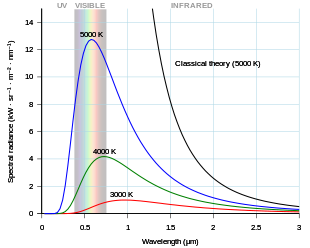
Back إشعاع الجسم الأسود Arabic কৃষ্ণকায় বিকিৰণ Assamese কৃষ্ণবস্তু বিকিরণ Bengali/Bangla Pelydriad corff du Welsh Hohlraumstrahlung German Nigra-korpa radiado Esperanto Radiación de cuerpo negro Spanish Musta keha kiirgus Estonian Gorputz beltzaren erradiazio Basque تابش جسم سیاه Persian
Black-body radiation is the thermal electromagnetic radiation within, or surrounding, a body in thermodynamic equilibrium with its environment, emitted by a black body (an idealized opaque, non-reflective body). It has a specific, continuous spectrum of wavelengths, inversely related to intensity, that depend only on the body's temperature, which is assumed, for the sake of calculations and theory, to be uniform and constant.[1][2][3][4]

A perfectly insulated enclosure which is in thermal equilibrium internally contains blackbody radiation, and will emit it through a hole made in its wall, provided the hole is small enough to have a negligible effect upon the equilibrium. The thermal radiation spontaneously emitted by many ordinary objects can be approximated as blackbody radiation.
Of particular importance, although planets and stars (including the Earth and Sun) are neither in thermal equilibrium with their surroundings nor perfect black bodies, blackbody radiation is still a good first approximation for the energy they emit. [5]
The term black body was introduced by Gustav Kirchhoff in 1860.[6] Blackbody radiation is also called thermal radiation, cavity radiation, complete radiation or temperature radiation.
- ^ Loudon 2000, Chapter 1.
- ^ Mandel & Wolf 1995, Chapter 13.
- ^ Kondepudi & Prigogine 1998, Chapter 11.
- ^ Landsberg 1990, Chapter 13.
- ^ Ian Morison (2008). Introduction to Astronomy and Cosmology. J Wiley & Sons. p. 48. ISBN 978-0-470-03333-3.
- ^ From (Kirchhoff, 1860) (Annalen der Physik und Chemie), p. 277: "Der Beweis, welcher für die ausgesprochene Behauptung hier gegeben werden soll, … vollkommen schwarze, oder kürzer schwarze, nennen." (The proof, which shall be given here for the proposition stated [above], rests on the assumption that bodies are conceivable which in the case of infinitely small thicknesses, completely absorb all rays that fall on them, thus [they] neither reflect nor transmit rays. I will call such bodies "completely black [bodies]" or more briefly "black [bodies]".) See also (Kirchhoff, 1860) (Philosophical Magazine), p. 2.